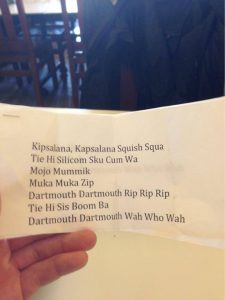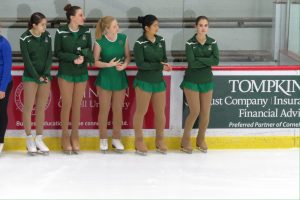General Information about Item:
- Verbal lore
- Language: English
- Country of Origin: United States
- Informant: CP
- Date Collected: 10/10/21
Informant Data:
- CP is a female Dartmouth student in the class of 2015. While at Dartmouth, she was a part of the Dartmouth cross country and track teams, competing as a distance athlete for her 4 years of college. CP was originally from Los Angeles but she now lives in the Bay Area and works as an engineer for a medical device startup company.
Contextual Data:
- Cultural Context: Before every cross country race or track meet begins, many teams will huddle together and do a team cheer. Not every team has to do it, but it is a very common practice. This will often be done on the starting line a few minutes before the starting gun goes off as a final team send off. Additionally, the words of the cheer can range widely between each team.
- Social Context: CP explained how this cheer was used by her team as a way to pump everyone up before a race. Something that is important to note about cross country races is that team scores are calculated by adding up the finishing place of the top 5 athletes for each team. In order to go to more important national meets, teams as a whole must do well, not just individuals on the team. Therefore, team cohesiveness is extremely important in cross country. This is why CP explains that this cheer brings the team together and reminds everyone that they are not alone and instead are working together, even though they may be running alone throughout the course of the race.
Item:
- The women’s team cheer was: “Who wears the black and white and green? Who is the best you’ve ever seen? What describes us best? Team. Go who? Go green!”
Associated audio recording:
Transcript:
AB: Ok do you want to just give a little bit of background like who you are, where you are from, your relation to Dartmouth, and that kind of stuff?
CP: Sure! Um, my name is CP. I was a Dartmouth ‘15, since then I have graduated and live in Bay Area, working. But, when I was at Dartmouth I was on the cross country and track teams, which I think is what we will be talking about today.
AB: Perfect. Ok, and then, let’s see. Yeah so do you want to just give me, like just say this piece of folklore that you’ve told me about?
CP: Sure! Um, yeah so when I was on the Dartmouth cross country team, um, I was on the women’s team and before every race that we had, we had a special cheer that we would say before we started racing. And that cheer, it went, “Who wears the black and white and green, who is the best you’ve ever seen, what describes us best, team. Go who? Go green!” and we would kind of alternate who said each part, but yeah. We would do that before every race and that was over my full four years on the team.
AB: Perfect. And is there anything, you know, that you can say about how this made you feel; how this got you pumped up for races; anything like that?
CP: Yeah, I definitely think this was kind of a way to pump the whole team up, just kind of like encourage everyone, get everyone excited, and get everyone in the–in the mood, um, ready for the race. And I think a lot of running cross country is about being on a team and you’re working together, you know, it’s very team-oriented. So even though you are running on your own, I think it’s, um, all the points are collectively put together as your team and that’s really how you go far in that sport. So, um, I think, yeah doing the cheer really kind of just brings you all together and makes you feel more like “yeah I’m not on my own here, I am with the rest of my team here” and really gets you ready to race.
AB: Perfect! Okay, thank you so much!
CP: Yeah, no problem.
Informant’s Comments:
- This cheer was used before most races and over the course of all of CP’s years at Dartmouth.
Collector’s Comments:
- The Dartmouth women’s cross country team cheer has changed in recent years since CP attended Dartmouth. However, the use of a team cheer to bring the team together pre-race is the same.
- This is a piece of verbal folklore, since it is something that was said by the women’s team before each race.
Collector’s Name: Abby Brazil




